Rare Dinosaur Trackways Saved from Floods
A Unique Set of Australian Dinosaur Tracks on the Move
A series of dinosaur tracks located around ninety minutes’ drive away from the town of Winton in Queensland, representing three different types of Late Cretaceous dinosaur, are being moved in order to protect and preserve them. The dinosaur footprints including a set of sauropod tracks, the hind prints of some which measure more than a metre across, represent the first substantial evidence of sauropod locomotion to be recorded from this part of Australia. In addition, the track of a chicken-sized theropod is preserved at this location, along with the larger, tridactyl prints of an ornithopod.
These tracks are the first recorded evidence of substantial walking tracks for sauropods in Australia and the first Cretaceous-aged sequence of solitary ornithopod tracks to have been identified “down under”.
An Aerial View Showing the Exposed Dinosaur Tracksite
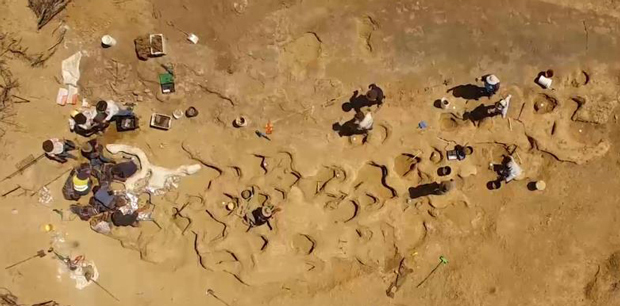
Picture credit: Australian Age of Dinosaurs Museum
First Dinosaur Tracks Exposed Nineteen Years Ago
The fossil trackways site was first exposed in the summer of 2000, when a small creek changed its course following substantial flooding across this part of central-west Queensland. The footprints were not recognised at first and lay exposed to the elements, slowly being bleached by the extreme heat and subjected to infrequent but devastating water damage. However, a major project to map and remove the tracks was begun in April 2018 by volunteers and staff from the Australian Age of Dinosaurs Museum.
It was soon realised that the dinosaur tracks, a series of depressions (hyporelief preservation), were extensive. The sauropod tracks consist of at least twenty prints and run for approximately forty metres. There is also evidence of the tracks having been made on the prints left by other sauropods including the tracks of a smaller long-necked dinosaur, tentatively described as a sub-adult.
Exposing the Dinosaur Tracks Using an Air Blast Hose
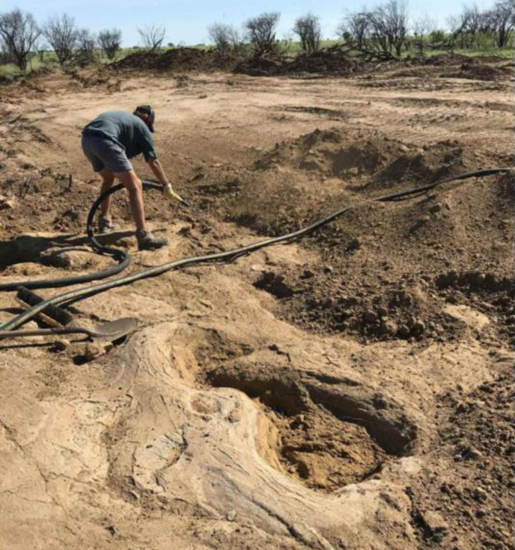
Picture credit: Australian Age of Dinosaurs Museum
Restoration and excavation work has been undertaken to help protect the fragile sandstone prints, conserve them and to prepare them for transport to the Museum, where they will form part of a major new exhibit, safe from further erosion.
Incredibly Rare Dinosaur Trackway Assemblage
It is incredibly rare to have major Suborders of the Dinosauria (Theropoda, Ornithopoda and Sauropoda), represented at the same fossil trackway site, in the same bedding plane.
Dr Stephen Poropot of the Australian Age of Dinosaurs Museum and the lead researcher on the project stated:
“The small ornithopod and theropod footprints were clearly made by very similar [if not identical] trackmakers to those preserved at Dinosaur Stampede National Monument, which is located about 100 kilometres south of this site”.
To read about the Dinosaur Stampede National Monument tracks preserved at Lark Hill Quarry: Lark Quarry Dinosaur Footprints – Scientists Re-examine the Evidence.
Dr Stephen Poropot Carefully Measuring the Dinosaur Tracks
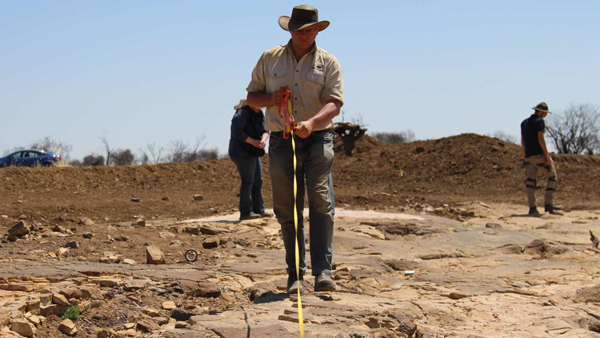
Picture credit: ABC Science/Belinda Smith
Significant Sauropod Tracks
According to Dr Poropot, the longest sequence of sauropod tracks identified at the site can be followed continuously and the thumb claw impressions from the front feet can be clearly made out. The sauropod prints are being heralded as the best of their kind found to date in Australia. The tracks were created approximately 95 million years ago (Cenomanian faunal stage of the Late Cretaceous) and many of the sauropod tracks are surrounded by concentric mud cracks that were spread through the wet sands as these giant creatures moved across the landscape.
The Three Different Types of Dinosaur Track in Close Proximity
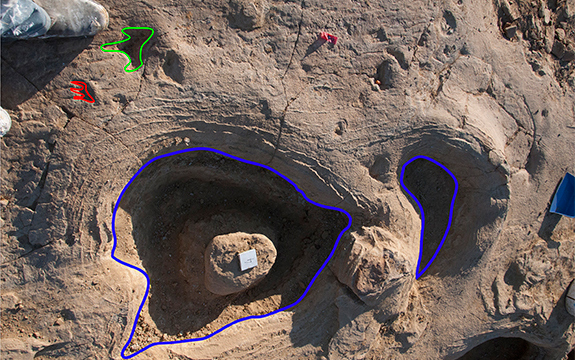
Picture credit: Swinburne University of Technology
Made by Titanosauriform Sauropods
These trace fossils cannot be assigned to any particular species of dinosaur. However, the deposit in which the fossils were found represents the Winton Formation and three genera of sauropods (all titanosaurs), have been described from these sandstone sediments to date:
- Savannasaurus elliottorum named in 2016.
- Diamantinasaurus matildae named in 2009 (it has been speculated that the sauropod tracks could have been made by Diamantinasaurus).
- Wintonotitan wattsi named in 2009.
Exposing the Titanosauriform Sauropod Tracks
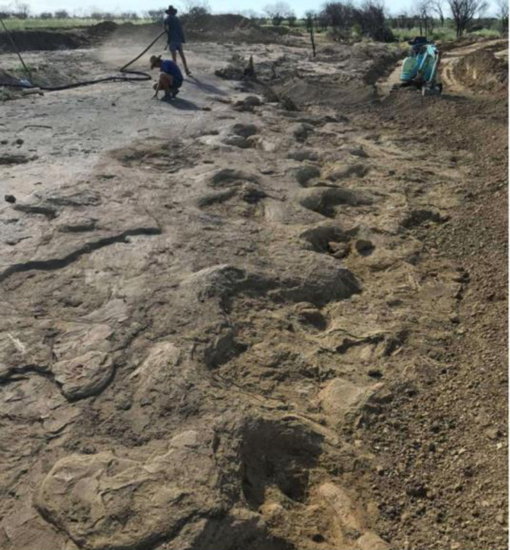
Picture credit: Australian Age of Dinosaurs Museum
David Elliott, Executive Chairman of the Australian Age of Dinosaurs Museum, who has been heavily involved with this sauropod-sized excavation and restoration project, explained that the relocation of the trackway began in September 2018 and twenty-five per cent of the total area, including all of the fragile footprints that were in danger of being destroyed, have now been removed.
He commented: “This is a very slow and painstaking process. The total weight of the trackway is in the vicinity of 500 tonnes and we are transporting it back to the Museum, one two-tonne trailer load at a time.”
A scientific analysis of the trackways interpreting dinosaur body size, gaits and potential sauropod herd dynamics, has been submitted for peer review by Dr Poropot and his colleagues and Mr Elliott is hoping that the attraction, named “March of the Titanosaurs”, will be open to the public from May of next year.
A Major Boost For Queensland Tourism
David Elliott added:
“Very few museums in the world can boast a multi-sequence sauropod trackway as one of their in-house exhibitions, much less one fifty-five metres long with the footprints of all three major groups of Dinosauria represented.”
A Close-up View of the Sauropod Tracks
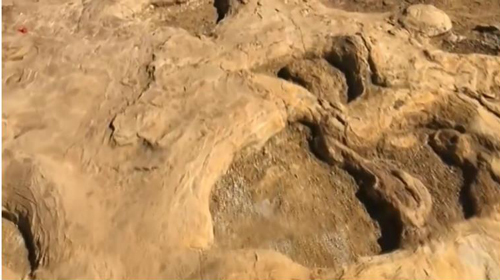
Picture credit: ABC Science/Belinda Smith
It is hoped that once opened in May 2020, “March of the Titanosaurs” will provide a major boost to tourism in this part of Queensland, especially after this area was hit by devastating floods recently. Had the project to remove the dinosaur tracks been delayed, it is likely that many of the prints would have been destroyed in the flooding.
A spokesperson from Everything Dinosaur commented:
“This has been a tremendous conservation effort, we congratulate all those involved. Thanks to this dedicated team, a hugely significant set of dinosaur trace fossils have been preserved.”
Visit the Everything Dinosaur website: Everything Dinosaur.

